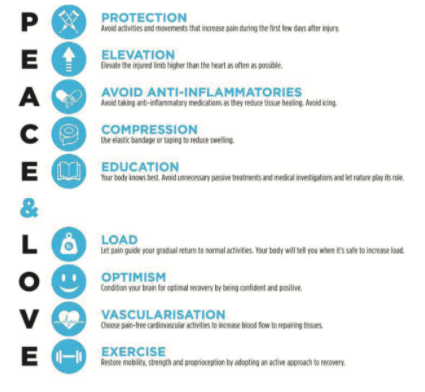
Acute Injury Management – Use PEACE!
March 8, 2021
By Taylor Blattenberger, DPT
Imagine you’re playing basketball with a friend; you go up for a lay-up and land awkwardly. You feel a familiar pain in your ankle and think you must have turned it again. As you limp off the court, you notice some swelling and think back to what you did the last time you sprained your ankle. You might have followed the principle of “RICE” (Rest, Ice, Compression, Elevation). This time you may want to try some different strategies. The British Journal of Sports Medicine recently released new guidelines for the treatment of acute injuries, which can help maximize healing and expedite recovery! Let’s see how you can give your injury some PEACE and LOVE.
Immediately after injury use PEACE:
Protection: The injured tissues may require immediate protection such as avoiding use or weight bearing. Use of an assistive device or brace may help with this in the first 1-3 days following an injury.
Elevation: Swelling is a hallmark sign of an acute injury, which helps our body provide nutrients and blood cells to the affected area. Elevation may help in avoiding excessive pooling of fluid and keep things moving.
Avoid Anti-inflammatories: While inflammation is associated with pain and other poor outcomes when it is prolonged, it may be beneficial to allow the initial inflammatory process to occur. This is our body’s natural healing response. Give a few days before using them.
Compression: Using an ace bandage or taping can also help to reduce swelling in the early stages.
Educate: Understand that acute injuries get better with time. The process can seem long and frustrating, but adhering to guidelines will help you stay on track. You can always consult your physical therapist for more specific recommendations and suggested next steps!
After the first few days have passed give your injury some LOVE:
Load: After initial immobilization it is important to load the area in ways you can tolerate. Light exercise with little to no pain promotes the repair process and builds tissue tolerance.
Optimism: Remember to stick with it. These injuries get better with time, hard work, and smart programming. Pain can be a normal part of the process, so don’t let it scare you.
Vascularization: Cardiovascular exercise has been shown to increase blood flow to the injured tissues and improve healing. It can also help the rest of your body maintain fitness and endurance while unloading the affected area.
Exercise: Time to regain your strength and mobility. Depending on your injury, there can be many different ways to rehabilitate and get you back to the things you enjoy. Physical therapists are movement experts and we here at Purcellville Orthopedic Physical Therapy are equipped to help maximize your function and recover. Tell us how we can help!